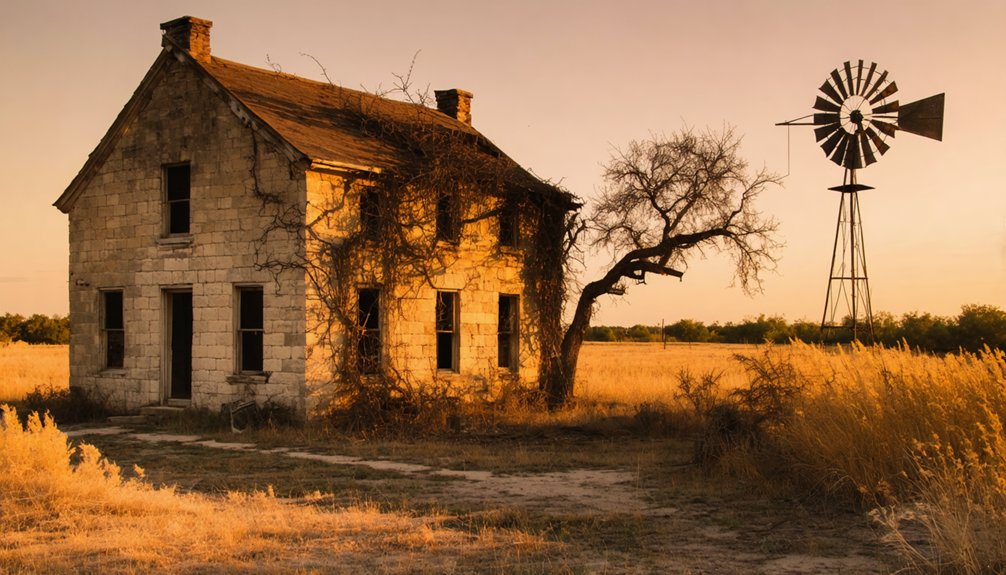You’ll find Hedwigs Hill nestled in Gillespie County’s granite country, where the Llano River carves through Texas Hill Country. Founded in 1844 by German settler Louis Martin, this frontier trading post once bustled with settlers, freight wagons, and commerce. Martin’s innovative dogtrot home served as the community’s heart until tragedy struck in 1864 with his murder. Today, the ghost town’s limestone ruins and Martin’s preserved homestead tell a deeper story of German pioneers, frontier justice, and Texas grit.
Key Takeaways
- Hedwigs Hill, established in 1844 by Louis Martin, declined after his tragic hanging in 1864 during a gold transport incident.
- The settlement’s population dwindled to just 10 residents by the 1930s, with its post office closing permanently in 1907.
- Martin’s historic dogtrot-style home, featuring connected log cabins, is preserved at the National Ranching Heritage Center.
- The ghost town sits along the Llano River, known for its granite formations and once-thriving agricultural and trading community.
- Hedwigs Hill now attracts tourists as part of Texas’s ghost town trail, though preservation efforts face ongoing challenges.
The German Roots of a Hill Country Settlement
Out in the heart of the Texas Hill Country, where the Llano River cuts through limestone bluffs, you’ll find the remnants of Hedwigs Hill – a settlement born from German determination in 1844.
Louis Martin, a bold German trader, carved out this piece of Texas paradise, naming it after his mother and daughter Hedwig. Like thousands of their countrymen, these pioneers sought freedom in the untamed hills that reminded them of their homeland.
Brave German settlers like Louis Martin forged new lives in Texas, carrying dreams of freedom and memories of their distant homeland.
You can still feel their German heritage in every corner of this land, where settlers built their dreams among dense forests and clear rivers. These early German influences live on today, much like in Hedwig Village where early German farmers left their legacy in street names.
They brought more than just farming skills and trading savvy – they carried their cultural traditions across the ocean, transforming this rugged terrain into a thriving community that married Texas grit with German resourcefulness. The settlers primarily relied on oxen for farming until the intense Texas heat forced them to switch to horses by 1860.
Life Along the Llano River
The rugged terrain of Llano River country tells a story written in stone and soil, where ancient granite domes rise above rolling plains and deep-cut valleys.
You’ll find the Llano River’s life-giving waters carving through a landscape that rises from 800 to 2,000 feet, creating a mosaic of opportunities for those who work the land.
Along the riverbank, you’ll spot sandy loams supporting mesquite and live oak groves, perfect for grazing cattle.
The rich soil yields to pecan orchards that thrive in this unique Llano River ecology.
Higher up, where clay soils dominate, Ashe junipers cling to hillsides, and the terrain demands a tougher approach to ranching.
This diverse ecosystem‘s riverbank agriculture follows nature’s lead, with farmers and ranchers adapting their practices to the river’s rhythms and the land’s character.
The area contains valuable deposits of Texas pink granite, which has become a significant construction material and cultural symbol.
The area’s distinctive geology stems from Precambrian basement high exposed through millennia of erosion.
The Legacy of Louis Martin
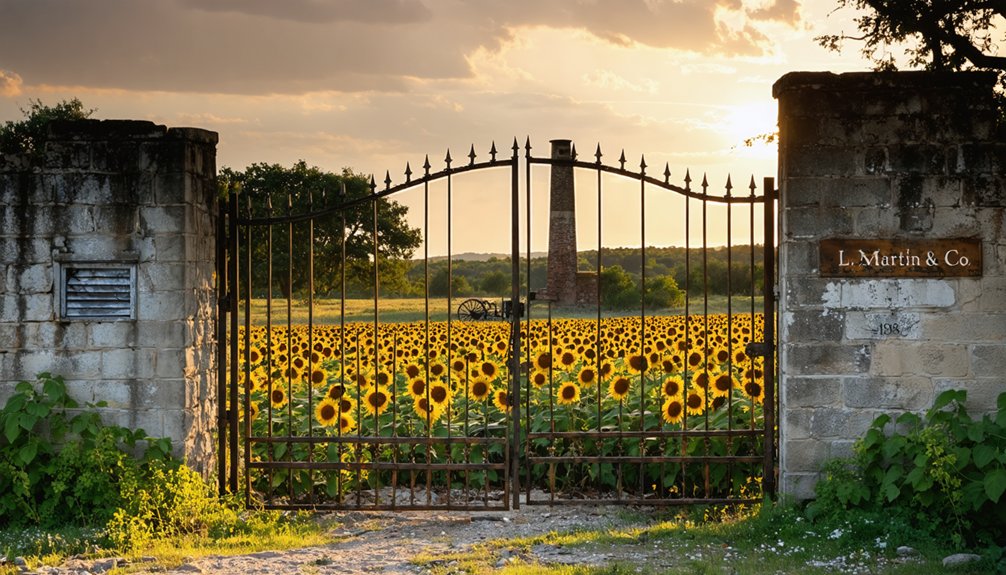
As one of Gillespie County’s earliest sheriffs, Louis Martin helped shape Hedwigs Hill from his strategic position along the Llano River’s north bank.
You’ll find his influence woven into every aspect of the settlement, from the dogtrot house he built in 1853 to the general store that served both locals and soldiers from nearby Fort Mason.
Through Martin’s leadership, Hedwigs Hill grew from a simple German immigrant settlement into an essential hub of commerce and community life in the Texas Hill Country. The settlement’s name honored Martin’s mother and daughter, both named Hedwig, reflecting his strong family ties to the community. His role as first postmaster in 1858 further cemented his importance to the growing settlement.
Sheriff’s Influential Leadership Role
Deep in the heart of Gillespie County, Louis Martin emerged as a pivotal figure who shaped early Texas law enforcement while earning $50 a year as the county’s first sheriff in 1846.
You’ll find his sheriff’s authority extended beyond typical law enforcement duties, as he wielded considerable influence among the German settlers who were carving out their dreams in the rugged Hill Country.
Martin’s approach to community governance reflected the independent spirit of frontier Texas. While maintaining order in this untamed territory, he established himself as a trusted leader who understood the delicate balance between enforcing the law and respecting the settlers’ fierce independence. His successful freight business operations supported crucial military installations, including Fort Martin Scott.
His role in shaping Gillespie County’s early days wasn’t just about wearing a badge – it was about building a foundation for a thriving frontier community. In 1858, he further demonstrated his leadership by becoming the first postmaster of the newly established settlement.
Building Hedwigs Hill’s Foundation
From humble beginnings in 1844, Louis Martin carved out his legacy in the Texas Hill Country after joining thousands of German settlers who ventured to the Republic through Meusebach’s colony program.
Alongside Christopher Voges, he co-founded what would become Hedwigs Hill, naming it after his mother and daughter. His innovative home featured two log cabins connected by a central breezeway, setting a standard for frontier architecture. By 1855, you’d find Martin’s influence growing as he purchased land in Gillespie County, built a distinctive dogtrot home on the Llano River’s north bank, and established a thriving general store.
His business ventures in freight transport and trade with Fort Mason sparked remarkable community growth and economic stability. Martin, who was born in Erndtebrück, brought his German heritage and entrepreneurial spirit to shape the developing Texas frontier.
Even after his tragic death in 1864, Martin’s foundation proved strong – his wife Anna expanded their empire to include 50,000 acres and the Commercial Bank of Mason.
A Frontier Trading Post
You’ll find Hedwigs Hill’s importance as a frontier trading post tied directly to its strategic position between Fort Mason and surrounding settlements.
As the Martin family’s general store grew into a crucial supply center, their freight wagons regularly traversed the rugged trails to Fort Mason, hauling everything from barbed wire to cotton.
The store’s proximity to major transportation routes made it a natural hub for both military and civilian commerce, connecting the isolated frontier settlements to wider trading networks.
Trading With Fort Mason
While pioneers carved out their lives in the Texas Hill Country, Fort Mason served as a essential lifeline for the growing settlement of Hedwigs Hill.
You’d find soldiers, settlers, and traders converging at this strategic outpost, established in 1851 on Post Oak Hill where Comanche and Centennial Creeks meet. The fort’s presence shaped trading relationships between settlers and Native American tribes, while providing critical protection for the folks at Hedwigs Hill.
The economic impact of Fort Mason ran deep through Mason County’s veins. You could trade goods, gather supplies, and share news at this frontier hub.
When Confederate forces took over in 1861, the region’s commerce suffered from increased raids, but the fort’s reopening in 1866 helped restore stability to your trading routes.
Pioneering Supply Center
The bustling frontier trading post of Hedwigs Hill emerged in 1853 as an essential lifeline for Mason County settlers, just five miles south of present-day Art along what’s now U.S. Highway 87.
You’d find the pioneering spirit alive at the Martin family’s store, where they’d stock everything from barbed wire to cattle supplies, serving as the backbone of the local supply chain.
The trading post wasn’t just about commerce – it was freedom incarnate. From this strategic location, freight wagons would roll out across the wild Texas frontier, sometimes venturing as far as Mexico carrying bacon and hidden gold.
Anna Martin, showing true Texas grit, expanded operations after her husband’s disability, amassing 50,000 acres and establishing the Commercial Bank of Mason in 1901.
Crime and Law Enforcement
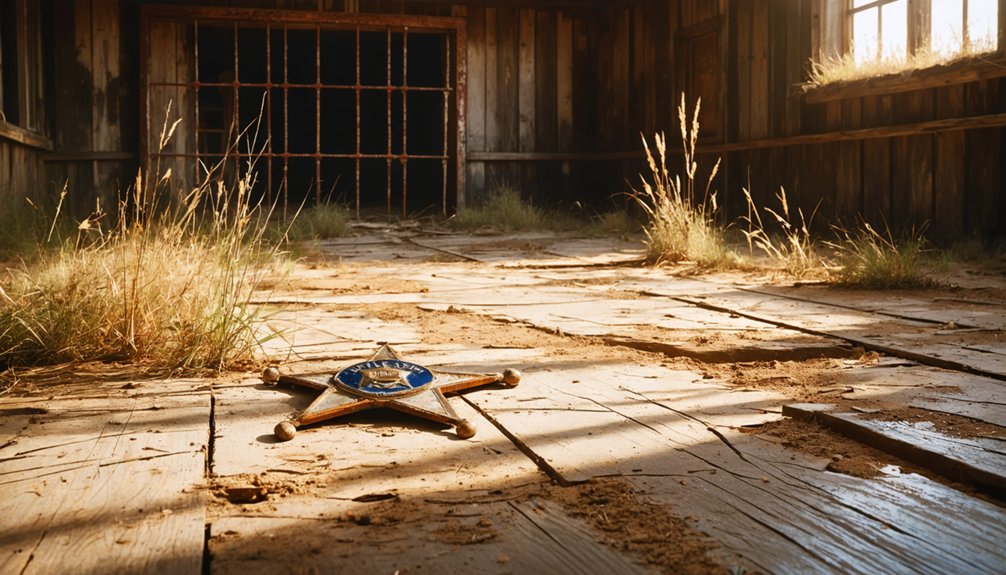
Living in Hedwigs Hill meant keeping one eye on your valuables and the other on passing strangers during its rough-and-tumble frontier days.
Crime statistics showed that ambushes, murders, and robberies were as common here as in any wild Texas town, with vigilante justice often serving as the only law of the land.
The 1864 hanging of Louis Martin and Eugene Frantzen by Confederate deserters during a gold transport highlighted the dangers that lurked on the dusty trails.
With minimal formal law enforcement, you’d have slept with your money bag under your pillow and kept your rifle close.
The town’s decline accelerated as violent incidents and theft became more frequent, driving folks away.
Like many Texas Hill Country settlements, Hedwigs Hill’s spirit of freedom eventually gave way to lawlessness.
Architecture and Notable Structures
Settlers in Hedwigs Hill built their homes with fierce practicality, adapting German architectural sensibilities to the demanding Texas Hill Country environment.
You’ll find no better example than Louis Martin’s dogtrot design house, built in 1855-56, which stood as the community’s social center. The home featured two log cabins joined by a breezeway that caught every precious breeze during scorching Texas summers.
These pioneer builders didn’t waste time hunting for fancy materials – they used what the land provided. Local limestone, cedar, and cypress became the backbone of every structure, from the general stores to the livestock pens near the Llano River.
Frontier pragmatism shaped every beam and stone – settlers built with nature’s offerings, turning local materials into lasting Hill Country landmarks.
While most of these buildings have returned to the earth, Martin’s home lives on at the National Ranching Heritage Center, telling the tale of rural materials meeting frontier innovation.
Post Office Era and Population Changes
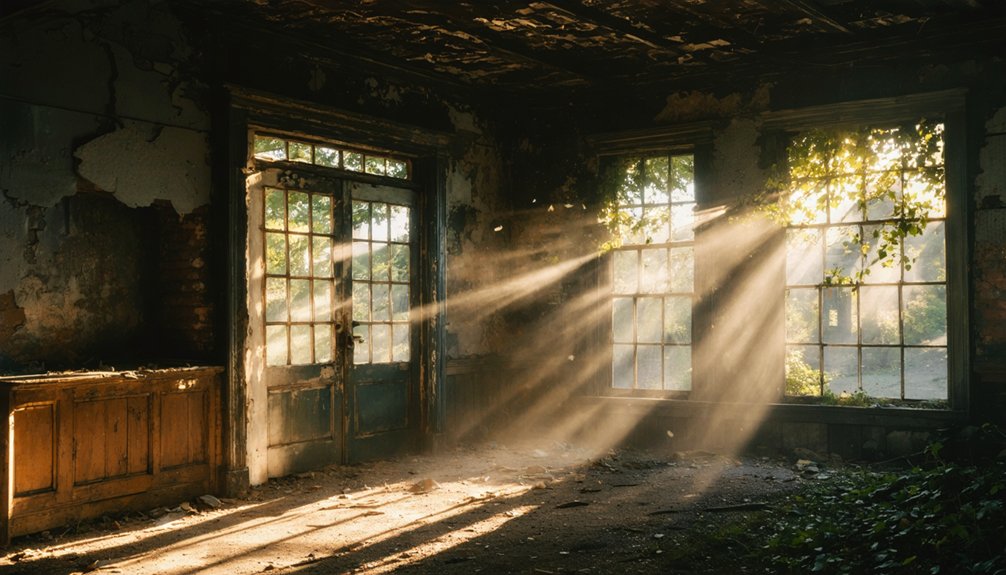
Deep in Mason County’s heart, Hedwigs Hill marked its place on the map when Louis Martin established the community’s first post office in June 1858.
You’ll find that this post office’s significance stretched beyond mail service, serving as a store, tavern, and polling place where frontier folk gathered to shape their destiny.
The post office’s story mirrors Hedwigs Hill’s own journey. After the Civil War, John Humphrey breathed new life into the operation, but by 1907, changing times forced its doors shut.
Population dynamics tell the tale of this German immigrant settlement – from its bustling early days to just 10 souls by the 1930s.
Though folks trickled back in the 1960s, Hedwigs Hill never reclaimed its former vigor, joining countless Texas frontier towns that time slowly transformed into ghost towns.
Natural Landscape and Resources
From its perch in Mason County’s Hill Country, Hedwigs Hill commands a view of classic Texas terrain – where granite outcrops burst through juniper-dotted slopes and seasonal creeks cut through the rocky soil.
Perched high in Mason County, Hedwigs Hill surveys ancient granite peaks rising through rugged slopes like sleeping giants.
You’ll find Texas oaks and mesquite trees thriving in these natural habitats, their roots gripping the well-drained earth where early settlers built their lives.
The lay of the land shaped everything about Hedwigs Hill’s story. Thirty miles northwest of the Llano River, folks learned water conservation quick, relying on springs and seasonal streams to sustain their cattle and sheep.
The granite bedrock proved useful for building foundations, while native hardwoods supplied timber for homes and fencing. It’s a land that demands respect – where nature’s cycles of rain and drought still dictate the rhythm of life.
Ghost Town Tourism and Preservation
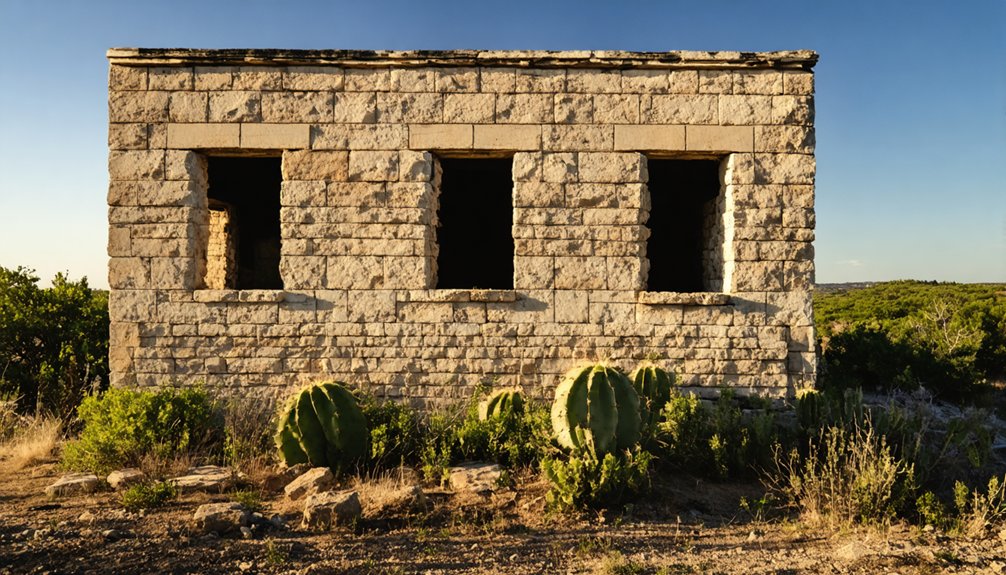
While Hedwigs Hill may look like just another quiet spot in the Hill Country nowadays, it’s become part of Texas’s growing ghost town tourism trail.
You’ll find the site’s rugged authenticity draws history buffs and adventure seekers alike, though preservation challenges have taken their toll on what remains of the settlement.
Like many Texas ghost towns, Hedwigs Hill faces the ongoing battle between nature’s reclamation and historical preservation.
Local efforts to protect the site rely heavily on tourism revenue and volunteer support, but limited infrastructure and the remote location make it tough to draw consistent visitors.
Still, you’ll discover that dedicated preservationists are working to maintain what’s left, ensuring future generations can experience this slice of Hill Country heritage.
Frequently Asked Questions
What Happened to Louis Martin’s Descendants After the Town Declined?
You’ll find most descendant stories follow typical patterns – they scattered to bigger Texas towns for work, while some kept family legacy alive through ranching or preserving their ancestral lands nearby.
Are There Any Annual Events or Festivals Held at Hedwigs Hill Today?
You won’t find any annual festivals or celebrations at Hedwigs Hill today. As a ghost town, it’s quiet now – though you’re welcome to explore the Hill Country’s other heritage events nearby.
What Was the Average Land Price in Hedwigs Hill During Its Peak?
Like a hidden treasure in Hill Country soil, you’d find land values varied widely. Though exact prices ain’t recorded, economic trends suggest several dollars to $1.25 per acre during peak settlement days.
Did Native American Tribes Interact With the Hedwigs Hill Settlement?
Y’all would’ve seen Native American interactions around those limestone hills, with Tonkawas being friendlier than Comanches. Tribal trade happened at nearby posts, but raids and conflicts were more common than commerce.
Were There Any Schools or Churches Established in Hedwigs Hill?
Despite having WiFi everywhere else, y’all won’t find any schools or churches in the settlement’s history. You’d have traveled to bigger towns nearby for your education and church community needs.
References
- https://txprobatelawyer.net/the-rise-of-ghost-towns-can-you-own-a-piece-of-abandoned-texas/
- https://ranchingheritage.org/explore/outdoor-historical-park/hedwigs-hill-dogtrot-house/
- https://www.texasescapes.com/MichaelBarr/Martin-House-Hedwigs-Hill.htm
- https://en.wikipedia.org/wiki/List_of_ghost_towns_in_Texas
- https://www.texasescapes.com/TexasHillCountryTowns/Hedwigs-Hill-Texas.htm
- https://www.tshaonline.org/handbook/entries/hedwigs-hill-tx
- https://www.tshaonline.org/handbook/entries/martin-louis
- https://www.texasalmanac.com/places/ghost-hill
- https://www.thecityofhedwigvillage.com/page/city_history
- https://losttexasroads.com/history/places/st-hedwig-texas/
